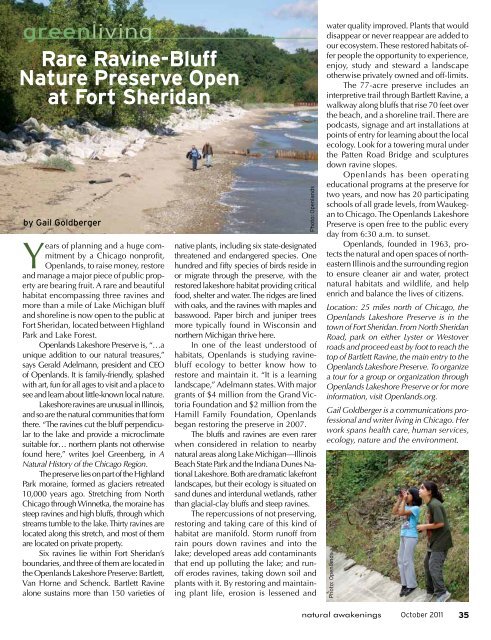STRAIGHTEN UP - Natural Awakenings
STRAIGHTEN UP - Natural Awakenings
STRAIGHTEN UP - Natural Awakenings
You also want an ePaper? Increase the reach of your titles
YUMPU automatically turns print PDFs into web optimized ePapers that Google loves.
greenliving<br />
Rare Ravine-bluff<br />
nature Preserve open<br />
at Fort sheridan<br />
by gail goldberger<br />
Years of planning and a huge commitment<br />
by a Chicago nonprofit,<br />
Openlands, to raise money, restore<br />
and manage a major piece of public property<br />
are bearing fruit. A rare and beautiful<br />
habitat encompassing three ravines and<br />
more than a mile of Lake Michigan bluff<br />
and shoreline is now open to the public at<br />
Fort Sheridan, located between Highland<br />
Park and Lake Forest.<br />
Openlands Lakeshore Preserve is, “…a<br />
unique addition to our natural treasures,”<br />
says Gerald Adelmann, president and CEO<br />
of Openlands. It is family-friendly, splashed<br />
with art, fun for all ages to visit and a place to<br />
see and learn about little-known local nature.<br />
Lakeshore ravines are unusual in Illinois,<br />
and so are the natural communities that form<br />
there. “The ravines cut the bluff perpendicular<br />
to the lake and provide a microclimate<br />
suitable for… northern plants not otherwise<br />
found here,” writes Joel Greenberg, in A<br />
<strong>Natural</strong> History of the Chicago Region.<br />
The preserve lies on part of the Highland<br />
Park moraine, formed as glaciers retreated<br />
10,000 years ago. Stretching from North<br />
Chicago through Winnetka, the moraine has<br />
steep ravines and high bluffs, through which<br />
streams tumble to the lake. Thirty ravines are<br />
located along this stretch, and most of them<br />
are located on private property.<br />
Six ravines lie within Fort Sheridan’s<br />
boundaries, and three of them are located in<br />
the Openlands Lakeshore Preserve: Bartlett,<br />
Van Horne and Schenck. Bartlett Ravine<br />
alone sustains more than 150 varieties of<br />
Photo: Openlands<br />
native plants, including six state-designated<br />
threatened and endangered species. One<br />
hundred and fifty species of birds reside in<br />
or migrate through the preserve, with the<br />
restored lakeshore habitat providing critical<br />
food, shelter and water. The ridges are lined<br />
with oaks, and the ravines with maples and<br />
basswood. Paper birch and juniper trees<br />
more typically found in Wisconsin and<br />
northern Michigan thrive here.<br />
In one of the least understood of<br />
habitats, Openlands is studying ravinebluff<br />
ecology to better know how to<br />
restore and maintain it. “It is a learning<br />
landscape,” Adelmann states. With major<br />
grants of $4 million from the Grand Victoria<br />
Foundation and $2 million from the<br />
Hamill Family Foundation, Openlands<br />
began restoring the preserve in 2007.<br />
The bluffs and ravines are even rarer<br />
when considered in relation to nearby<br />
natural areas along Lake Michigan—Illinois<br />
Beach State Park and the Indiana Dunes National<br />
Lakeshore. Both are dramatic lakefront<br />
landscapes, but their ecology is situated on<br />
sand dunes and interdunal wetlands, rather<br />
than glacial-clay bluffs and steep ravines.<br />
The repercussions of not preserving,<br />
restoring and taking care of this kind of<br />
habitat are manifold. Storm runoff from<br />
rain pours down ravines and into the<br />
lake; developed areas add contaminants<br />
that end up polluting the lake; and runoff<br />
erodes ravines, taking down soil and<br />
plants with it. By restoring and maintaining<br />
plant life, erosion is lessened and<br />
water quality improved. Plants that would<br />
disappear or never reappear are added to<br />
our ecosystem. These restored habitats offer<br />
people the opportunity to experience,<br />
enjoy, study and steward a landscape<br />
otherwise privately owned and off-limits.<br />
The 77-acre preserve includes an<br />
interpretive trail through Bartlett Ravine, a<br />
walkway along bluffs that rise 70 feet over<br />
the beach, and a shoreline trail. There are<br />
podcasts, signage and art installations at<br />
points of entry for learning about the local<br />
ecology. Look for a towering mural under<br />
the Patten Road Bridge and sculptures<br />
down ravine slopes.<br />
Openlands has been operating<br />
educational programs at the preserve for<br />
two years, and now has 20 participating<br />
schools of all grade levels, from Waukegan<br />
to Chicago. The Openlands Lakeshore<br />
Preserve is open free to the public every<br />
day from 6:30 a.m. to sunset.<br />
Openlands, founded in 1963, protects<br />
the natural and open spaces of northeastern<br />
Illinois and the surrounding region<br />
to ensure cleaner air and water, protect<br />
natural habitats and wildlife, and help<br />
enrich and balance the lives of citizens.<br />
Location: 25 miles north of Chicago, the<br />
Openlands Lakeshore Preserve is in the<br />
town of Fort Sheridan. From North Sheridan<br />
Road, park on either Lyster or Westover<br />
roads and proceed east by foot to reach the<br />
top of Bartlett Ravine, the main entry to the<br />
Openlands Lakeshore Preserve. To organize<br />
a tour for a group or organization through<br />
Openlands Lakeshore Preserve or for more<br />
information, visit Openlands.org.<br />
Gail Goldberger is a communications professional<br />
and writer living in Chicago. Her<br />
work spans health care, human services,<br />
ecology, nature and the environment.<br />
Photo: Openlands<br />
natural awakenings October 2011<br />
35





